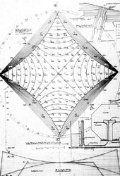The first lectures on road construction were given as early as 1829 in combination with building, bridge and river construction, and a few years later also on railway construction. Hydraulic engineering dates back to 1847. Civil engineering was introduced as a separate teaching and research area at the Stuttgart Polytechnic in 1862. Initially, structural engineering was a special focus. The "Geodetic Institute" was founded in 1865 as part of surveying, followed by the "Institute for Photogrammetry" in 1929. In 1903, an independent chair for "Water Supply, Meliorations, Dams and Urban Sewerage" was established, which was divided into "Hydraulic Engineering" and "Road Construction and Urban Construction" in 1925. 
On these first basic units of teaching and research in civil engineering and surveying, today's structures developed in close succession. With the transition of the polytechnic into a technical university in 1890 and the transformation of this into a university in 1967, new faculties were set up which united teaching and research fields close to one another. The original "Faculty of Civil Engineering", which included architecture and civil engineering, goes back to this. In the seventies the two faculties "Architecture and Urban Planning" and "Civil Engineering and Surveying" were derived from this.
In the process, restructuring has taken place and continues to take place, which has inevitably resulted in the further development of the initial classical fields from specific technical advances, the current international changes in research landscapes and teaching content, as well as from the looming prospects for the future. New names and definitions of the characteristic teaching and research units were the logical consequence for the reasons mentioned above. Surveying, for example, underwent a new orientation towards geodesy and geoinformatics, which also involved a change to Faculty 6: Aerospace Engineering (since then "and Geodesy"). After the introduction of the two independent study courses "Environmental Engineering" (1994) and "Real Estate Engineering and Economics" (2001) to supplement the Civil Engineering Department in addition to the three English-language Master's programmes "Infrastructure Planning", "Water Resources Engineering and Management (WAREM)" and "Computational Mechanics of Materials and Structures (COMMAS)", the current faculty was renamed "Civil and Environmental Engineering" in 2003. It is divided into 14 institutes, each with one or more chairs and research institutes. In the winter semester 2012/2013, the range of courses was rounded off by the study course "Traffic Engineering".
Personalities

Theodor Fischer: Founder of the Stuttgart School of Architecture
Emil Mörsch: Founder of the "Theory of Concrete Iron Constructions“
Otto Graf: Material and component testing
Paul Bonatz: Architecture and Urban Planning
Richard Döcker: Construction management of the Weißenhof housing estate
Fritz Leonhardt: New construction method for bridges and television towers

